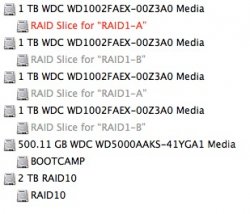Hi!
I'm including this in the Mac Pro forum as the nMP is the only desktop with TB2 for the moment.
The limitations of many TB drive enclosures (over TB1) are pretty well-known. TB adds more bandwidth, but in thinking about this I have been unable to confirm the answers to a question:
If the nMP supports TB2 but one has two separate TB enclosures (say there are 2 SSDs in RAID0 in each), could the user essentially create a (software) RAID0 of those 2 enclosures and see a performance increase, or would that not materialize?
There are only a few enclosures shipping today that are TB2 (well, maybe only the R4), and further only a few will be upgradable (e.g. Sonnet Echo Express models). Some new ones (e.g. OWC Mercury Pro Dual) are being released as TB1.
I got to thinking that maybe TB2 isn't such a necessary thing right now...that one could buy a TB1 enclosure and when (/if ever) more speed is needed, a larger RAID0 could be created by daisy-chaining the TB1 devices. Not sure if in the case of the nMP it would be better to daisy chain the TB1 enclosures or hang them off of different TB lanes.
Any thoughts?
Also, will a TB2 device (eg R4) simply run at TB1 speeds if the host computer (MBA, iMac) only supports TB1?
Thank you!
I'm including this in the Mac Pro forum as the nMP is the only desktop with TB2 for the moment.
The limitations of many TB drive enclosures (over TB1) are pretty well-known. TB adds more bandwidth, but in thinking about this I have been unable to confirm the answers to a question:
If the nMP supports TB2 but one has two separate TB enclosures (say there are 2 SSDs in RAID0 in each), could the user essentially create a (software) RAID0 of those 2 enclosures and see a performance increase, or would that not materialize?
There are only a few enclosures shipping today that are TB2 (well, maybe only the R4), and further only a few will be upgradable (e.g. Sonnet Echo Express models). Some new ones (e.g. OWC Mercury Pro Dual) are being released as TB1.
I got to thinking that maybe TB2 isn't such a necessary thing right now...that one could buy a TB1 enclosure and when (/if ever) more speed is needed, a larger RAID0 could be created by daisy-chaining the TB1 devices. Not sure if in the case of the nMP it would be better to daisy chain the TB1 enclosures or hang them off of different TB lanes.
Any thoughts?
Also, will a TB2 device (eg R4) simply run at TB1 speeds if the host computer (MBA, iMac) only supports TB1?
Thank you!


